 | | | 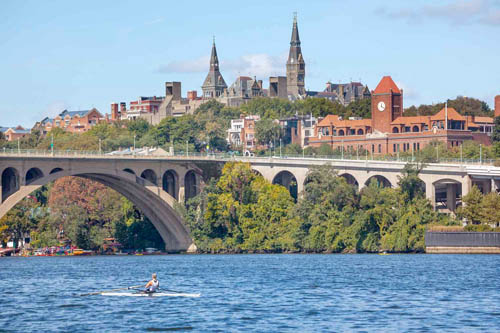 Happy World Ocean Month! As June comes to a close, summer is officially in full swing. I hope that you are staying cool amidst the record-breaking heat and making a point to spend time in or near a body of water. It is also a perfect time to revisit Rachel Carson’s The Sea Around Us. Even if you aren’t able to get all the way to a coast, find your nearest river, bay, or stream and reflect on the incredible power of the ocean and its inextricable connections to the health and well-being of our society. As someone who grew up in a beach town, now living in DC, I find myself drawn to the banks of the Potomac every chance I get. It isn’t quite the same, but I find just being in the presence of a large body of water deeply reassuring and relaxing. Happy World Ocean Month! As June comes to a close, summer is officially in full swing. I hope that you are staying cool amidst the record-breaking heat and making a point to spend time in or near a body of water. It is also a perfect time to revisit Rachel Carson’s The Sea Around Us. Even if you aren’t able to get all the way to a coast, find your nearest river, bay, or stream and reflect on the incredible power of the ocean and its inextricable connections to the health and well-being of our society. As someone who grew up in a beach town, now living in DC, I find myself drawn to the banks of the Potomac every chance I get. It isn’t quite the same, but I find just being in the presence of a large body of water deeply reassuring and relaxing. 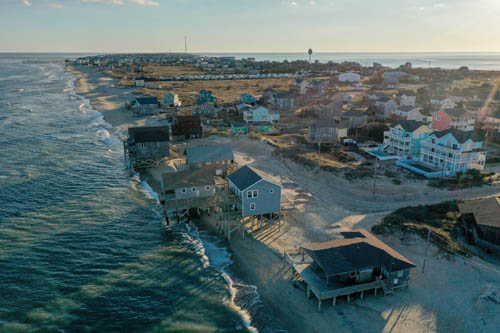 This June issue of the RCC Coasts and Ocean Observer has in store for you waves of breaking ocean and coastal news. Starting with our shores, we look at how our nation’s beaches are increasingly threatened by sea-level rise and storms. RCC Stanback Fellow, Zoe Kolenovsky, examines the pattern of houses collapsing off the North Carolina coast because of climate-change induced coastal erosion. And, given the current practice of managing beach erosion through sand replenishment, often referred to as “beach nourishment”, the North Carolina Coastal Review reveals that we may be outpacing the available supply of viable beach sand. This June issue of the RCC Coasts and Ocean Observer has in store for you waves of breaking ocean and coastal news. Starting with our shores, we look at how our nation’s beaches are increasingly threatened by sea-level rise and storms. RCC Stanback Fellow, Zoe Kolenovsky, examines the pattern of houses collapsing off the North Carolina coast because of climate-change induced coastal erosion. And, given the current practice of managing beach erosion through sand replenishment, often referred to as “beach nourishment”, the North Carolina Coastal Review reveals that we may be outpacing the available supply of viable beach sand. Moving further inland, we check in on the status of American wetlands, just over a year after the Sackett v. EPA decision severely limited the EPA’s ability to protect wetland areas. Then thinking about marine pollution, we feature stories on litigation seeking to make Big Oil and PFAS producers pay for the environmental and social justice damages they are causing. Finally, you can explore the current state of global fisheries and what one Smithsonian scientist is doing to verify the identity of species being sold on the seafood market. 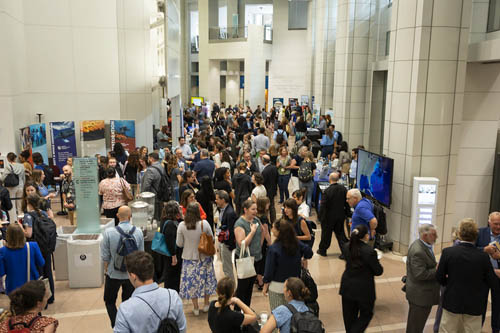 All of these ocean issues washed ashore in Washington, DC during June’s Capitol Hill Ocean Week (CHOW). You can read more about my experience at CHOW among an inspiring group of ocean advocates, experts, government leaders, and more. You can also find in-depth articles about some of the major announcements that came out of CHOW – including the official designation of the Lake Ontario National Marine Sanctuary and the final management plan for the Mariana Trench Marine National Monument. All of these ocean issues washed ashore in Washington, DC during June’s Capitol Hill Ocean Week (CHOW). You can read more about my experience at CHOW among an inspiring group of ocean advocates, experts, government leaders, and more. You can also find in-depth articles about some of the major announcements that came out of CHOW – including the official designation of the Lake Ontario National Marine Sanctuary and the final management plan for the Mariana Trench Marine National Monument.
We close out our June issue with recommendations for viewing two educational television programs. The first is close to home. Against the Current reveals what life on Virginia’s Eastern Shore is like and how climate effects are changing communities that have been around there for generations. 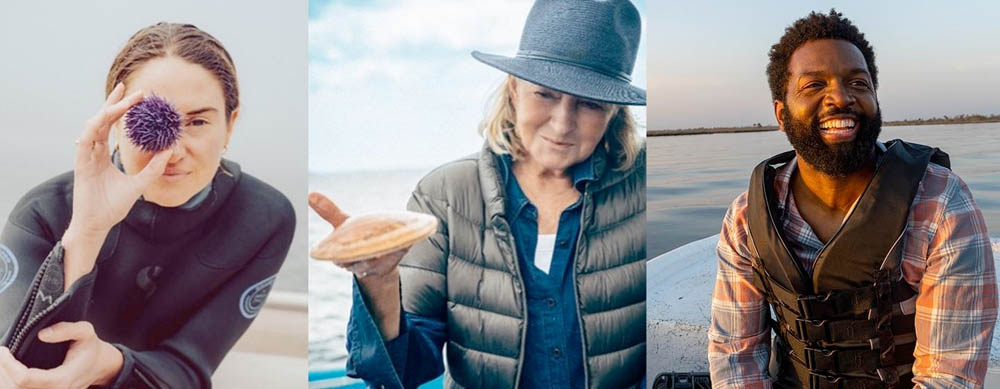 The other is a series called Hope in the Water. It follows stories about sustainable fisheries and aquaculture – focusing on how to feed our growing population while caring for and prioritizing ocean health. With that, farewell to Ocean Month and welcome to summer! | | | | | | | |  RCC Stanback Presidential Fellow – Chloe Wetzler RCC Stanback Presidential Fellow – Chloe Wetzler
Chloe Wetzler is the co-lead of the RCC Coasts and Ocean program. She is a dual Master of Environmental Management and Juris Doctor student at Duke’s Nicholas School of the Environment and Law School. At Duke, she is the symposium coordinator for the Ocean Policy Working Group and a student researcher for the Nicholas Institute of Environment, Energy, and Sustainability. | | | | | | The Ocean Comes to the Capitol Every June, just before beach season, advocates for protection of the ocean and marine life flood the nation’s capital and wash across Capitol Hill hoping to get the public and policy makers to realize that the nearly three-quarters of our planet that shimmers in blue from those classic space photos is what life on Earth depends upon. Capitol Hill Ocean Week, or CHOW, is both an extended conference and advocacy days hosted by the National Marine Sanctuary Foundation during Ocean Month. | | | | | | | | The Ocean Floor Is Dangerous. We Should Keep Exploring It. A year ago, the world was transfixed by the Titan implosion thousands of feet underwater. Writer James Nestor argues that we should still go deep. By the time we’d reached the bottom of the Cayman Trench, some 2,000 feet below the ocean’s surface, I’d lost feeling in my legs. My neck was aching, and my ears felt as though they were going to explode under the mounting pressure. | | | | | | | | William & Mary Pursues Bachelor’s in Marine Science at School of Marine Science Proposed program would be first public undergraduate marine science degree in Virginia. William & Mary is moving forward with a proposal for the first undergraduate marine science program at a public university in Virginia. The Board of Visitors approved the measure to submit plans for the degree to the State Council for Higher Education in Virginia (SCHEV). That review process by SCHEV will determine whether the university may implement the new program. | | | | | | | | Red Knots, Horseshoe Crabs, and Us Conservationist Drew Lanham's call for the care of kinship It’s an annual ritual, the flocks of red-breasted shorebirds landing to refuel along the Atlantic shores of South Carolina during one of the longest migrations in the animal kingdom. The red knots’ layover on their journey from the Patagonia region of South America to the Arctic is timed to the spring spawning of horseshoe crabs and the abundance of eggs lining the beaches. But red knots have been less plentiful of late, so much so they are now protected under the Endangered Species Act. | | | | | | | | NOAA Unveils New Lake Ontario National Marine Sanctuary The National Oceanic and Atmospheric Administration (NOAA) announced today the designation of the Lake Ontario National Marine Sanctuary as the 16th sanctuary in a system of underwater parks that encompasses 620,000 square miles of ocean and Great Lakes waters. “We’re excited to celebrate this day,” said Oswego County Legislature Chairman James Weatherup. “This designation marks an incredible achievement for Oswego County and its partners. | | | | | | | | First Baby Eagles Hatch on Reborn Chesapeake Island Some eagle-eyed wildlife biologists have made a surprising discovery at Poplar Island. That’s the island in Maryland’s portion of the Chesapeake Bay that the U.S. Army Corps of Engineers and Maryland Port Authority have been rebuilding over the last 25 years. What was once almost entirely open water is now more than 1,700 acres of rock-ringed land. | | | | | | | | Save a Blue Crab, Eat a Blue Catfish The blue crab population has been struggling. For the last four years experts say, it has experienced significant declines, negatively affecting the economy and ecology of the Chesapeake Bay. Yet, for some studying blue crab populations, the answer to preserving the species is simple. Allison Colden, executive director of the Chesapeake Bay Foundation Maryland, said one of the best ways to help preserve and uplift the rise of blue crabs in the Chesapeake Bay is by eating more blue catfish. | | | | | | | | Horseshoe Crabs Are Harvested For Their Blood. Is Maryland Hiding Their Deaths? Maryland is hiding the number of horseshoe crabs that are killed or bled annually, according to a nonprofit. The Center for Biological Diversity, a conservation-focused organization, sued the state’s Department of Natural Resources under Maryland’s Public Information Act for “failing to release information detailing exactly how thousands of horseshoe crabs are killed, bled or injured by pharmaceutical companies and fishermen annually.” | | | | | | | | | | How a Virginia Hatchery is Using Science to Save Freshwater Mussels Every minute or so, a tiny black dot on a white, 1/16-inch diameter circle peeks out from the edge of a pocketbook mussel’s shell. It’s fishing, not realizing it’s no longer at home in the Potomac River. Instead, it’s in a plastic basin at the Harrison Lake Fish Hatchery in Charles City County, where a more than 2-decade-long effort to restore what may be the most endangered group of animals in the world has found ways around a challenge any fisherman knows. | | | | | | | | Your Guide to Reef Friendly Sunscreen! This Summer Choose Minerals Over Chemicals A big concern among ocean scientists and beachgoers is the impact that chemical sunscreens are having on the marine environment. Decades of research documenting ecotoxicity to coral reefs and other marine life has led to bans on the sale and use of certain chemical sunscreens in states and island communities such as Hawaii, US Virgin Islands and Aruba. | | | | | | | | Restoring Indigenous Aquaculture Heals Both Ecosystems and Communities in Hawai‘i For generations, native Hawaiians have understood that their aquaculture systems, fishponds known as loko i‘a, serve as nurseries that seed fish populations in surrounding waters. For the first time, a team of scientists from the Hawaiʻi Institute of Marine Biology (HIMB) have modeled this feat of Indigenous science in a study. “We are using science to translate ‘ike kupuna, or Indigenous knowledge, into policy,” said study co-author Kawika Winter. | | | | | | | | Coastal Marten Gains Federal Protection The recent federal protection for the Oregon-California coastal marten is a crucial step in wildlife conservation. By designating 1.2 million acres as critical habitat, this protection aims to address the severe habitat loss and population decline faced by the coastal marten. This effort aligns with our campaign to Save Oregon’s Oldest Trees, which are essential for the marten’s habitat. Old-growth forests provide shelter and food for the marten, and protecting these trees supports broader biodiversity. | | | | | | | | Biden-Harris Administration Publishes Final Management Plan for Mariana Trench Marine National Monument Plan advances administration’s goal to conserve and restore 30 percent of nation’s lands and waters by 2030. NOAA Fisheries, the U.S. Fish and Wildlife Service, and the Commonwealth of the Northern Mariana Islands released the final management plan and environmental assessment for the Mariana Trench Marine National Monument. | | | | | | | | Scientists and Indigenous Leaders Team Up to Conserve Seals and an Ancestral Way of Life at Yakutat, Alaska Five hundred years ago, in a mountain-rimmed ocean fjord in southeast Alaska, Tlingit hunters armed with bone-tipped harpoons eased their canoes through chunks of floating ice, stalking seals near Sít Tlein (Hubbard) glacier. They must have glanced nervously up at the glacier’s looming, fractured face, aware that cascades of ice could thunder down and imperil the boats – and their lives. | | | | | | | | Marine Heat Waves Create Habitat Squeeze in the Chesapeake, Research Shows Unlike humans, who usually experience heat waves only in the summer, marine life can find itself in hot water, or marine heat waves, throughout the year. While the topic is well-researched in the world’s oceans, little is known at a smaller scale. The Virginia Institute of Marine Science wrangled 35 years of data to release the first study that analyzes marine heat waves below the first meter of water in an estuary, especially in the Chesapeake Bay. | | | | | | | | To Mark Baltimore Harbor Cleanup Progress, Public Invited to Jump In Feel like jumping in Baltimore’s harbor? Here’s your chance. The city’s Waterfront Partnership, convinced that it’s finally safe to swim there after a 14-year cleanup campaign, has scheduled an organized dip on Sunday, June 23. Dubbed “Harbor Splash,” the event will give up to 125 people (18 or older) a chance to get in the water for a supervised swim off Bond Street Wharf in Fells Point. | | | | | | | | New York State Legislature Strikes A Blow Against Plastic Pollution Going, going, almost gone! Just-passed New York State legislation would prohibit the sale and distribution of fossil fuel–based, water-polluting polystyrene foam ice chests. The New York State Senate and Assembly have just passed identical bills (S4414A/A4943A) that would ban the sale and distribution of the ubiquitous white foam cold-storage coolers, except for those used for medical purposes, beginning January 1, 2026. | | | | | | | | California Advances Bill to Strengthen Ban on Plastic Bags California’s state Senate and Assembly each passed identical bills on Tuesday that would strengthen California’s ban on single-use plastic grocery bags.. Sen. Catherine Blakespear’s (Encinitas) SB 1053 passed the Senate by an initial 30-7 vote and Asm. Rebecca Bauer-Kahan’s (Orinda) AB 2236 passed the Assembly by a 51-7 vote. Their passage marks an important step in addressing California’s plastic waste crisis by closing a loophole that allows grocery stores to provide thick plastic bags for a fee. | | | | | | | | Is Biodegradable Plastic Really a Thing? Technically, it exists. But here’s what to think about when shopping. On the face of it, biodegradable plastic is a miracle. It looks like plastic and works much like plastic. And it goes back to nature after you throw it away. But there’s a big catch: Just because your plastic fork, cup or doggy poop bag is marketed as biodegradable, that doesn’t necessarily mean it’ll break down in the environment. The same goes for so-called compostable plastic. Here’s why. | | | | | | | | Shellfish Harvesting Closed Along Entire Oregon Coast This comes after, 20 people fell ill from eating mussels gathered at Short Beach near Oceanside and at Hug Point near Seaside in May. The Oregon Department of Agriculture and the Oregon Department of Fish and Wildlife announced the expansion of closures along the entire Oregon coast on Thursday. The agencies said that illnesses consistent with paralytic shellfish poisoning have been reported from harvested bivalve shellfish. Samples also taken from the coast have exceeded the limit for paralytic shellfish poisoning. | | | | | | | | On the Power of a Salt Marsh Salt marshes—often trampled, built on, and filled in—are giant, silent carbon sinks. On their oversized and underappreciated role in the health of our planet. THE PLACE I’M HOUSESITTING overlooks a vast tidal marsh. The entire marsh side of the house is windows, so I spend a lot of time with my eyes on that flat sweep of wet earth—a tessellation of yellows that are almost green, and greens almost yellow, and sea blues that turn mud brown as the tide pulls out. | | | | | | | | Climate Change-induced Coastal Erosion Causes NC Houses to Collapse, Poses Additional Threats A waterfront house in Rodanthe, N.C. — a coastal town located on Hatteras Island in the Outer Banks — collapsed into the Atlantic Ocean the morning of May 28. The five-bedroom house built in 1970 was unoccupied at the time, and local officials closed a one-mile stretch of beach around the property for two days to remove debris. This isn’t the first time this has happened. According to the National Park Service, last month’s collapse is the sixth such event on the barrier island in the past four years | | | | | | | | As Temperatures Rise, Stay Away From Algal Blooms North Carolina Department of Environmental Quality officials are cautioning people to stay away from discolored water as summer temperatures set in this holiday weekend. As of last Tuesday, the department’s Division of Water Quality had received reports of 11 confirmed or suspected algal blooms, two of which contained cyanobacteria, or blue-green algae. Cyanobacteria are found in freshwater, estuarine and marine waters, and while they are important to aquatic ecosystems, some are able to produce cyanotoxins. | | | | | | | | Middle Peninsula Marshes and Living Shorelines Create Benefits Valued at $6.4 Million Annually It turns out that a sustainable approach to shoreline management not only has important ecological benefits for plants and wildlife, it also has a significant economic impact. Marshes and living shorelines in the Middle Peninsula region of Virginia generate more than $6.4 million in economic value from recreational fishing, a figure more than three and a half times greater than the value associated with hardened shorelines. | | | | | | | | The Homeowner Mutiny Leaving Florida Cities Defenseless Against Hurricanes The federal government is refusing to restore eroded beaches in Pinellas County unless homeowners agree to one condition: public access. Lisa Hendrickson is almost out of sand. Hendrickson is the mayor of Redington Shores, Florida, a well-heeled beach town in Pinellas County. Her town occupies a small section of a razor-thin barrier island that stretches down the western side of the sprawling Tampa Bay metro area, dividing cities like Tampa and St. Petersburg from the Gulf of Mexico. | | | | | | | | One Year After Loss Of Wetlands Protection: Sackett v. Environmental Protection Agency One year ago, on May 25, 2023, the United States Supreme Court issued its opinion in Sackett v. Environmental Protection Agency, overruling over 50 years of well-established protections for surface waters and wetlands by dramatically narrowing the scope of the Clean Water Act and the Environmental Protection Agency’s authority. | | | | | | | | NC Bill Threatens Historic Coastal Areas, Including a Native American Burial Site A bill moving through the General Assembly would allow developers in the state’s 20 coastal counties to build on archaeological sites, including one in Carteret County that state archaeologists say could be the location of a village where Native Americans lived for thousands of years. Under a provision added to House Bill 385, the “incidental disturbance of archaeological resources” would not be considered major and irreversible damage. | | | | | | | | Stormwater Hits D.C.’s Poorest Neighborhoods Hardest, UMD Study Finds A new University of Maryland study suggests that Washington, D.C.’s most socioeconomically vulnerable neighborhoods are less equipped to handle runoff from heavy rainfalls made more frequent by climate change. Published this month in Cities, the study reveals that the most densely populated communities in the District of Columbia, particularly in historically Black Southeast D.C., lack critical public resources. | | | | | | | | Nonprofit Supports Next Generation of Black Commercial Captains The nonprofit Minorities in Aquaculture has already made headlines paving the way for women and people of color in oyster growing. Now, the group’s founder has set her sights on supporting Black maritime captains, too. Chestertown, Kent County, native Imani Black founded Minorities in Aquaculture in 2020, when she was the only woman of color working as a oyster hatchery manager. Her mission was to give underrepresented groups better opportunities in Bay industries. | | | | | | | | NC House Bill Would Make PFAS Polluters Pay to Clean Up Drinking Water The North Carolina House Environment Committee voted in support of a bill that would put the responsibility of cleanup costs for drinking water on PFAS manufacturers. A bill is moving forward in the state legislature that would require PFAS polluters to pay up. More than 50 drinking water systems in North Carolina are contaminated with PFAS, also known as forever chemicals, according to the Department of Environmental Quality. | | | | | | | | Biden-Harris Administration Invests $60 Million to Build a Climate-ready Workforce Through Investing in America Agenda Today, the Department of Commerce and NOAA announced $60 million in funding to help train and place people in jobs that advance a climate-ready workforce for coastal and Great Lakes states, Tribes and Territories as part of President Biden’s Investing in America agenda under the Inflation Reduction Act. To date, awards like these from President Biden’s Investing in America agenda have created more than 270,000 jobs across the country. | | | | | | | | NC Cut Its Wetlands Rules. Now Millions of Acres May Be Vulnerable. A provision in last year’s North Carolina Farm Act declared that state wetlands protections could not be any stricter than those defined by the federal Clean Water Act, a change that exposes more than 2 million acres of the state’s isolated wetlands to development. Mike Carpenter, general counsel for the N.C. Home Builders Association, which sought the change, said at the time that it was not the threat that environmental advocates were claiming. | | | | | | | | Some Coastal NC Towns’ Beach Sand Needs May Go Unmet If North Carolina beaches are going to keep up their tug-of-war with the sea to maintain robust ocean shores, they’re going to need sand and a lot of it. But, in an era when mining sand and pumping it onto beaches has become a go-to means of fortifying shores against erosion and storms, finding that just-right type of sand and enough of it for the foreseeable future might prove to be quite the challenge for many of the state’s coastal communities. | | | | | | | | The Hidden Language of Ocean Coral For Logan Brenner, an adjunct associate research scientist at Columbia University’s Lamont-Doherty Earth Observatory, joining the International Ocean Drilling Project’s (IODP) Expedition 389: Hawaiian Drowned Reefs was a dream opportunity. The project offered Brenner a chance to work among a group of scientists spanning nations, including Austria, China, France, Germany, Japan, Spain, and the U.K., and disciplines—physicists, geochemists, sedimentologists, paleomagnetists—and to further her own research into the planet’s past. | | | | | | | | Humpback Whale Population Data Offers Grim Prognosis For Ocean Health Regulating whaling, shipping routes and fishing nets have had a clear positive impact on whale survival, but offsetting ocean warming is a much loftier task. The North Pacific humpback whale, once on the brink of extinction due to hunting, is now facing another threat to its survival, according to a recent study that chronicled an alarming climate change trend. | | | | | | | | Supreme Court Ruling Delays Climate Litigation Big Oil Has Sought to Thwart Court seeks Biden administration’s view as fossil fuel industry fights to avoid trial in lawsuits The supreme court on Monday asked the Biden administration to weigh in on big oil’s request to thwart litigation that could put them on the hook for billions of dollars. The one-line order will delay the litigation from advancing to trial. It follows an unprecedented pressure campaign from far-right fossil fuel allies on the court. | | | | | | | | The World is Farming More Seafood Than it Catches. Is That a Good Thing? Both aquaculture and fisheries have environmental and climate impacts — and they overlap more than you'd think. A new report from the United Nations’ Food and Agriculture Organization, or FAO, has found that more fish were farmed worldwide in 2022 than harvested from the wild, an apparent first. | | | | | | | | Meet the Museum Scientist Who Sails the Ocean and Sifts Through Seafood Markets to Identify Fishes From field sites in Vietnam and the coast of West Africa to her laboratory in Washington, D.C., Kate Bemis applies her knowledge of fish diversity to support sustainable fisheries Fishes are key to keeping the world fed. Fishes provide nearly seven percent of global protein intake. And with some communities relying on seafood for most of their protein, sustainable fisheries and seafood safety are critical. | | | | | | | | 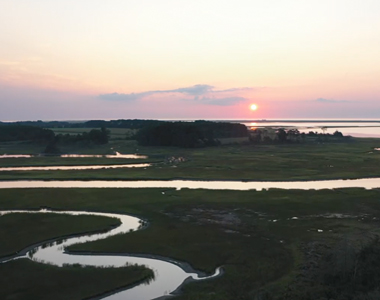 New PBS Documentary Features Work on the Eastern Shore New PBS Documentary Features Work on the Eastern Shore
A documentary that aired on PBS highlights the challenges the Eastern Shore faces, with an emphasis on UVA's work to address flooding and resilience on the coast. “Against the Current” provides a powerful glimpse of how Virginia’s Eastern Shore residents are subject to the challenges of rising water’s effects on their lives and livelihood. Through resilience and perseverance, they learn to co-exist and celebrate their rural home. How can this unique community shed light on the national conversations happening around these climate issues? | | | | | | | | 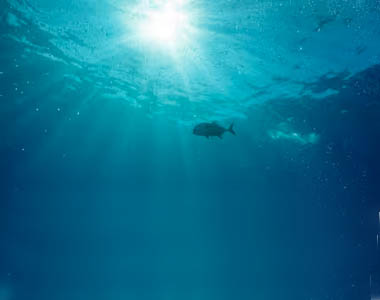 Hope in the Water Hope in the Water
The story of people who are feeding our growing planet while working to save our oceans.
From Emmy Award winning producer Andrew Zimmern, in collaboration with multi-award-winner and storytelling visionary David E. Kelley, Hope in the Water explores the groundbreaking work of dedicated fishers, aqua farmers, and scientists who are attempting what was once thought impossible: harvesting aquatic species to feed our growing planet while saving our oceans. | | | | | | | | The June 2024 issue of RCC Coasts and Ocean was produced by Ross Feldner | | | | | |  The Rachel Carson Council Depends on Tax-deductible Gifts From Concerned Individuals Like You. Please Help If You Can. The Rachel Carson Council Depends on Tax-deductible Gifts From Concerned Individuals Like You. Please Help If You Can. | | | | | | | |  Sign Up Here to Receive the RCC E-News and Other RCC Newsletters, Information and Alerts. Sign Up Here to Receive the RCC E-News and Other RCC Newsletters, Information and Alerts. | | | | | | | | | | | |